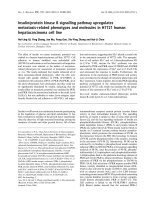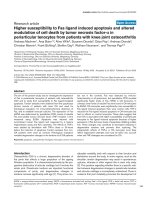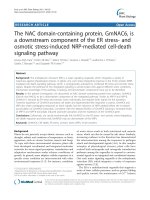The role of adenosine, adenosine receptors and transporters in the modulation of cell death
Bạn đang xem bản rút gọn của tài liệu. Xem và tải ngay bản đầy đủ của tài liệu tại đây (4.21 MB, 278 trang )
THE ROLE OF ADENOSINE, ADENOSINE RECEPTORS
AND TRANSPORTERS IN THE MODULATION OF
CELL DEATH
SUN WENTIAN
(B. Sci.; M. Sci.)
A THESIS SUBMITTED FOR THE DEGREE OF
DOCTOR OF PHILOSOPHY
DEPARTMENT OF BIOCHEMISTRY
NATIONAL UNIVERSITY OF SINGAPORE
JULY 2008
ABSTRACT
In this research, the apoptotic effects of adenosine and the mechanisms by which
adenosine exerts these effects were studied. Adenosine-induced apoptosis was
characterized by both early and late stage apoptosis criteria and observed to be
cell type-dependent. Using different adenosine receptor agonists and antagonists,
it was found that GPCRs can mediate apoptosis at low adenosine concentrations
while nucleoside transporters are involved in the apoptotic effects at high
adenosine concentrations. Receptors and transporters of adenosine appeared to
mediate the contrasting biphasic, non-biphasic apoptotic and non-apoptotic effects
of adenosine observed in different cell types. Key players/events of the apoptosis
were identified, including the hyperpolarization and depolarization of
mitochondria, translocation of Bax and cytochrome c, elevation of cytosolic Ca
2+
level, cellular acidification and activation of caspases. An intrinsic apoptosis
pattern was suggested with mitochondria being at the centre of the apoptosis
pathway. Based on the experimental data, an intracellular mechanism for
adenosine-induced apoptosis was proposed. In this model, two apoptotic signaling
pathways respond to adenosine at low and high extracellular adenosine
concentrations. This model also provides an explanation for the multifaceted
character of adenosine-induced apoptosis across a wide range of adenosine
concentrations and cell types.
i
ACKNOWLEDGEMENTS
I would like to thank my supervisor Associate Professor Tan Chee Hong and my
co-supervisor Associate Professor Khoo Hoon Eng for their supervision,
mentoring, encouragement and help throughout the course of the research.
A special debt of gratitude is owned to Miss Ng Foong Har for her help in my
research.
My heartfelt thanks also go to Mr Yau Yin Hoe, Miss Beatrice Goh, Miss Poon
Yoke Yin, Dr Wei Changli, Dr Wang Yawen and Mr Wu Feiyi for their support
and encouragement in the research, and, for the memory we shared.
I acknowledge the receipt of the Research Scholarship from the National
University of Singapore and the research fund (R-183-000-064-213) for
biomedical research from National Medical Research Council.
Last but not least, my gratefulness to my parents and my wife Sabrina for their
endless love.
ii
CONTENTS
Acknowledgements i
Contents ii
List of figures ix
List of tables
xv
Abbreviations
xvi
Summary xx
Chapter 1 Introduction
1.1 Adenosine and Its Receptors 1
1.1.1 Adenosine Structure and Functions 1
1.1.1.1 Adenosine: A Pursuit of 80 Years 1
1.1.1.2 Physiological Roles of Adenosine 4
1.1.2 Adenosine/P1 Receptors 6
1.1.2.1 Classification and Nomenclature of Adenosine/P1 Receptors 6
1.1.2.2 Signal Transduction of Adenosine/P1 Receptors 14
1.1.2.2.1 Signal Transduction of A
1
Receptors 14
1.1.2.2.2 Signal Transduction of A
2A
and A
2B
Receptors 17
1.1.2.2.3 Signal Transduction of A
3
Receptors 19
iii
1.1.3 Nucleoside Transporters 21
1.1.4 The Physiological Distributions of Adenosine 24
1.1.4.1 Physiological Release of Adenosine 24
1.1.4.2 Pathological Release of Adenosine 27
1.1.4.3 Nucleoside/Nucleotide Release by Cell Death 28
1.2 Apoptosis 29
1.2.1 Apoptosis: Past and Present 29
1.2.2 Physiological and Pathological Significance of Apoptosis 30
1.2.3 Bcl-2 Family Proteins 31
1.2.4 Caspases 32
1.2.5 Intrinsic and Extrinsic Apoptotic Signaling Pathways 34
1.3 Adenosine-Induced Apoptosis (AIA) 36
1.4 Aim of Study 41
Chapter 2 Materials and Methods
2.1 Materials 42
2.1.1 Chemicals 42
2.1.2 Instruments 45
2.2 Methods 46
2.2.1 Cell Culture 46
2.2.1.1 Normal Cell Culture 46
2.2.1.2 Cytopreservation 47
2.2.1.3 Thawing of Cryopreserved Cells 47
2.2.1.4 Cell culture for AIA studies 48
iv
2.2.2 DNA Extraction from Cells 48
2.2.3 Agarose Gel Electrophoresis of DNA 49
2.2.4 Photography of DNA Electrophoresis Gels 49
2.2.5 Flow Cytometry 49
2.2.5.1 Cell Cycle Studies 50
2.2.5.2 Intracellular pH Level Studies 50
2.2.5.3 Intracellular Ca
2+
Level Studies 51
2.2.6 Mitochondria Membrane Potential Studies 52
2.2.7 Early Stage and Late Stage Apoptosis Determination 52
2.2.8 Isolation of Mitochondria from Mouse Liver 53
2.2.9 Total Cell Lysate Preparation 54
2.2.10 Immunoprecipitation 54
2.2.11 SDS-PAGE (sodium dodecyl sulfate-polyacrylamide gel
electrophoresis)
55
2.2.12 Protein Estimation 56
2.2.13 Western Blotting 56
2.2.14 Statistics 58
Chapter 3 Mechanisms of Adenosine-Induced Apoptosis
3.1 Adenosine-Induced Apoptosis (AIA) 59
3.2 Apoptotic Effect Studies of Adenosine 63
3.2.1 Biphasic Apoptosis Induced by Adenosine in BHK Cells 63
3.2.2 Non-biphasic Apoptosis Induced by Adenosine in HeLa,
SKW6.4 and H9 Cells
65
v
3.2.3 Non-apoptotic Effect of Adenosine in SY5Y and MN9D Cells 68
3.3 Involvement of P1 Receptors in AIA in BHK Cells 73
3.3.1 A
1
Receptors 73
3.3.2 A
2A
and A
2B
Receptors 76
3.3.3 A
3
Receptors 79
3.3.4 Expression of P1 receptors in BHK Cells 82
3.4 Involvement of Nucleoside Transporters in AIA in BHK Cells 84
3.4.1
es
Transporters 84
3.4.2
ei
Transporters 86
3.4.3 Effect of Propentofylline 88
3.5 Involvement of P1 receptors in dose-dependent AIA 90
3.5.1 Involvement of Receptors in AIA in HeLa cells 90
3.5.1.1 A
1
Receptor in AIA in HeLa Cells 90
3.5.1.2 A
2A
and A
2B
Receptors in AIA in HeLa Cells 94
3.5.1.3 A
3
Receptor in AIA in HeLa Cells 97
3.5.2 Involvement of Receptors in AIA in SKW6.4 cells 100
3.5.2.1 A
1
Receptors in AIA in SKW6.4 Cells 100
3.5.2.2 A
2A
and A
2B
Receptors in AIA in SKW6.4 Cells 103
3.5.2.3 A
3
Receptors in AIA in SKW6.4 Cells 106
3.5.3 Involvement of Receptors in AIA in H9 Cells 109
3.5.3.1 A
1
receptor in AIA in H9 Cells 109
3.5.3.2 A
2A
and A
2B
receptors in AIA in H9 Cells 112
3.5.3.3 A
3
receptor in AIA in H9 Cells 115
vi
3.6 Involvement of Nucleoside Transporters in Dose-dependent
AIA
118
3.6.1
es
Transporters in HeLa Cells 118
3.6.2
ei
Transporters in HeLa Cells 120
3.6.3
es
Transporters in SKW6.4 Cells 122
3.6.4
ei
Transporters in SKW6.4 Cells 124
3.6.5
es
Transporters in H9 Cells 126
3.6.6
ei
Transporters in H9 Cells 128
3.7 Involvement of Mitochondria in AIA in BHK Cells 130
3.7.1 Mitochondrial Membrane Potential (MMP) Changes during AIA 130
3.7.2 Mitochondrial Membrane Hyperpolarization 131
3.8 Translocation of Bax and Cytochrome c 134
3.9 Intracellular Ca
2+
Level during AIA 136
3.10 pH Changes during AIA 146
3.11 Involvement of Caspases during AIA in BHK Cells 160
3.11.1 Activation of Caspase 3 160
3.11.2 Activation of Caspase 8 162
3.11.3 Activation of Caspase 9 164
3.12 Involvement of Caspases during AIA in SKW6.4 Cells 166
3.12.1 Activation of Caspase 3 166
3.12.2 Activation of Caspase 8 168
3.12.3 Activation of Caspase 9 170
vii
Chapter 4 Discussion
4.1 Adenosine-Induced Apoptosis (AIA) 172
4.2 Extracellular Mechanism of Adenosine-induced Apoptosis 176
4.2.1 GPCR-mediated Apoptosis in BHK Cells 176
4.2.2 Transporter-mediated Apoptosis in BHK Cells 180
4.2.3 An Extracellular Model for Biphasic, Non-biphasic Apoptotic
and Non-Apoptotic Effects of Adenosine
186
4.3 Intracellular Mechanism of Adenosine-induced Apoptosis 187
4.3.1 Mitochondrial Hyperpolarization and Depolarization during AIA 188
4.3.2 Cytochrome
c
Release during AIA 192
4.3.3 Intracellular Ca
2+
Elevation during AIA 198
4.3.4 Intracellular Acidification during AIA 200
4.3.5 Activation of Caspases during AIA 202
4.4 An Integrated Model for AIA 204
4.4.1 The Origin and Fate of Adenosine 210
4.4.2 Signaling Pathways of Adenosine 213
4.4.3 An Integrated Model for AIA in BHK Cells 215
4.5 Implications of the Findings of the Study 217
4.5.1 A Better Understanding of Adenosine Physiology 217
4.5.2 GPCR-mediated Apoptosis 217
4.5.3 Mitochondria-mediated Apoptosis in Type I Cells 217
4.5.4 Mechanism of Cytochrome c Release 218
4.5.5 Pharmaceutical Implications 218
viii
Chapter 5 Conclusion and Future Directions
5.1 Conclusion
219
5.2 Future Directions
221
5.2.1 Studies of Adenosine-Induced Apoptosis 221
5.2.2 Adenosine and Adenosine Analogues for Tumor-Control and/or
Tumor Suppression
222
Reference 223
Appendix A Solutions 242
Appendix B Supplemental Data 249
Appendix C Publication 250
ix
LIST OF FIGURES
Fig. 1.1 Chemical structure of adenosine 3
Fig. 1.2 Schematic of the A
1
adenosine receptor 10
Fig. 1.3 Chemical structures of some agonists at adenosine/P1 receptors 11
Fig. 1.4 The chemical structures of some antagonists at adenosine/P1
receptors
12
Fig. 3.1 Induction of BHK cell apoptosis by adenosine 62
Fig. 3.2 Biphasic apoptotic effect of adenosine in BHK cells 64
Fig. 3.3 Apoptotic effects of adenosine on HeLa cells 66
Fig. 3.4 Apoptotic effects of adenosine on SKW6.4 and H9 cells 67
Fig. 3.5 Apoptotic effects of adenosine on SY5Y and MN9D cells 69
Fig. 3.6 Apoptotic effects of CCPA on SY5Y and MN9D cells 70
Fig. 3.7 Apoptotic effects of CGS21680 on SY5Y and MN9D cells 71
Fig. 3.8 Apoptotic effects of IB-MECA on SY5Y and MN9D cells 72
Fig. 3.9 Effect of A
1
receptor inhibition by DPCPX on AIA in BHK cells 74
Fig. 3.10 Effect of A
1
receptor activation by CCPA on apoptosis in BHK
cells
75
Fig. 3.11 Effect of A
2
receptor inhibition by DMPX on AIA in BHK cells 77
Fig. 3.12 Effect of A
2
receptor activation by CGS-21680 on apoptosis in
BHK cells
78
x
Fig. 3.13 Effect of A
3
receptor activation by MRS-1220 on AIA in BHK
cells
80
Fig. 3.14 Effect of A
3
receptor activation by IB-MECA on apoptosis in
BHK cells
81
Fig. 3.15 Expression of purinoceptors in BHK cells 83
Fig. 3.16 Effect of
es
transporter inhibition by NBTI on AIA in BHK cells 85
Fig. 3.17 Effect of dipyridamole (DIP) on AIA in BHK cells 87
Fig. 3.18 Effect of combined receptor and transporter inhibition by
propentofylline (PPF) on AIA in BHK cells
89
Fig. 3.19 Effect of A
1
receptor inhibition by XAC on AIA in HeLa cells 92
Fig. 3.20 Effect of A
1
receptor activation by CCPA on apoptosis in HeLa
cells
93
Fig. 3.21 Effect of A
2
receptor inhibition by DMPX on AIA in HeLa cells 95
Fig. 3.22 Effect of A
2
receptor activation by CGS-21680 on apoptosis in
HeLa cells
96
Fig. 3.23 Effect of A
3
receptor inhibition by MRS-1220 on AIA in HeLa
cells
98
Fig. 3.24 Effect of A
3
receptor activation by IB-MECA on apoptosis in
HeLa cells
99
Fig. 3.25 Effect of A
1
receptor inhibition by DPCPX on AIA in SKW6.4
cells
101
Fig. 3.26 Effect of A
1
receptor activation by CCPA on apoptosis in
SKW6.4 cells
102
xi
Fig. 3.27 Effect of A
2
receptor inhibition by DMPX on apoptosis in
SKW6.4 cells
104
Fig. 3.28 Effect of A
2
receptor activation by CGS-21680 on AIA in
SKW6.4 cells
105
Fig. 3.29 Effect of A
3
receptor inhibition by MRS-1220 on AIA in
SKW6.4 cells
107
Fig. 3.30 Effect of A
3
receptor activation by IB-MECA on apoptosis in
SKW6.4 cells
108
Fig. 3.31 Effect of A
1
receptor inhibition by DPCPX on AIA in H9 cells 110
Fig. 3.32 Effect of A
1
receptor activation by CCPA on apoptosis in H9
cells
111
Fig. 3.33 Effect of A
2
receptor inhibition by DMPX on AIA in H9 cells 113
Fig. 3.34 Effect of A
2
receptor activation by CGS-21680 on apoptosis in
H9 cells
114
Fig. 3.35 Effect of A
3
receptor inhibition by MRS-1220 on AIA in H9 cells 116
Fig. 3.36 Effect of A
3
receptor activation by IB-MECA on apoptosis in H9
cells
117
Fig. 3.37 Effect of NBTI on AIA in HeLa cells 119
Fig. 3.38 Effect of dipyridamole on AIA in HeLa cells 121
Fig. 3.39 Effect of NBTI on AIA in SKW6.4 cells 123
Fig. 3.40 Effect of dipyridamole on AIA in SKW6.4 cells 125
Fig. 3.41 Effect of NBTI on AIA in H9 cells 127
Fig. 3.42 Effect of dipyridamole on AIA in H9 cells 129
xii
Fig. 3.43 Loss of mitochondrial membrane potential during adenosine-
induced apoptosis in BHK cells
132
Fig. 3.44 Mitochondrial membrane hyperpolarization during adenosine-
induced apoptosis in BHK cells
133
Fig. 3.45 Translocation of Bax and Cyt
c
during the adenosine-induced
apoptosis in BHK cells
135
Fig. 3.46 Intracellular Ca
++
level changes during AIA in BHK cells
(negative control)
137
Fig. 3.47 Intracellular Ca
++
level changes during AIA in BHK cells (0 min) 138
Fig. 3.48 Intracellular Ca
++
level changes during AIA in BHK cells (5 min) 139
Fig. 3.49 Intracellular Ca
++
level changes during AIA in BHK cells (10
min)
140
Fig. 3.50 Intracellular Ca
++
level changes during AIA in BHK cells (20
min)
141
Fig. 3.51 Effects of DPCPX & MRS-1220 on the intracellular Ca
++
level
changes (0 min)
142
Fig. 3.52 Effects of DPCPX & MRS-1220 on the intracellular Ca
++
level
changes (5 min)
143
Fig. 3.53 Effects of DPCPX & MRS-1220 on the intracellular Ca
++
level
changes (10 min)
144
Fig. 3.54 Effects of DPCPX & MRS-1220 on the intracellular Ca
++
level
changes (20 min)
145
Fig. 3.55 Intracellular pH changes during AIA in BHK cells (negative
control)
147
Fig. 3.56 Intracellular pH changes during AIA in BHK cells (0 min) 148
xiii
Fig. 3.57 Intracellular pH changes during AIA in BHK cells (5 min) 149
Fig. 3.58 Intracellular pH changes during AIA in BHK cells (10 min) 150
Fig. 3.59 Intracellular pH changes during AIA in BHK cells (20 min) 151
Fig. 3.60 Intracellular pH changes during AIA in BHK cells (30 min) 152
Fig. 3.61 Intracellular pH changes during AIA in BHK cells (40 min) 153
Fig. 3.62 Intracellular pH changes during AIA in BHK cells (50 min) 154
Fig. 3.63 Intracellular pH changes during AIA in BHK cells (60 min) 155
Fig. 3.64 Intracellular pH changes during AIA in BHK cells (90 min) 156
Fig. 3.65 Intracellular pH changes during AIA in BHK cells (4 hrs) 157
Fig. 3.66 Intracellular pH changes during AIA in BHK cells (5 hrs) 158
Fig. 3.67 Intracellular pH changes during AIA in BHK cells (6 hrs) 159
Fig. 3.68 Caspase-3 activity during the adenosine-induced apoptosis in
BHK cells
161
Fig. 3.69 Caspase-8 activity during the adenosine-induced apoptosis in
BHK cells
163
Fig. 3.70 Activation of caspase 9 during the adenosine-induced apoptosis
in BHK cells
165
Fig. 3.71 Caspase-3 activity during the adenosine-induced apoptosis in
SKW6.4 cells
167
Fig. 3.72 Caspase-8 activity during the adenosine-induced apoptosis in
SKW6.4 cells
169
Fig. 3.73 Activation of caspase 9 during the adenosine-induced apoptosis
in SKW6.4 cells
171
xiv
Fig. 4.1 Pathways of adenosine production, metaboloism and transport,
with indications of the sites of action of various enzyme
inhibitors
205
Fig. 4.2 Adenosine receptor signaling pathways 206
Fig. 4.3 An integrated model for adenosine-induced apoptosis. 208
Fig. S-1 BHK cells treated with combinations of receptor antagonists and
transporter inhibitor
249
Fig. S-2 1 mM adenosine does not cause cyt c release from mitochondria
directly
249
xv
LIST OF TABLES
Table 1 Families of receptors for purine and pyrimidine nucleosides and
nucleotides
8
Table 2 Classification of adenosine/P1 receptors 16
Table 3 Amino acid sequencehomologies (%) between human adenosine
receptor subtypes
20
Table 4 Family of nucleoside transporters 23
Table 5 Effects of extracellular purines on cell growth 38
Table 6 Strategies of the extracellular mechanism studies of AIA in BHK
cells
184
Table 7 Strategies of the extracellular mechanism studies of AIA in HeLa
cells
185
xvi
ABBREVIATIONS
AC adenylyl cyclase
Ac-DEVD-AMC N-acetyl-Asp-Glu-Val-Asp-AMC
Ac-DEVD-CHO N-acetyl-Asp-Glu-Val-Asp-CHO
Ac-IETD-AFC N-acetyl-Ile-Glu-Thr-Asp-AFC
Ac-IETD-CHO N-acetyl-Ile-Glu-Thr-Asp-CHO
ADP adenosine 5’-diphosphate
AIA adenosine-induced apoptosis
AIF apoptosis inducing factor
AMP adenosine 5’-monophosphate
ANT adenine nucleotide translocator
APS ammonium persulfate
AR adenosine receptor
ASFV african swine fever virus
ATP Adenosine 5’-triphosphate
Bcl-2 B
cell lymphoma
BHK Baby Hamster Kidney cells
BSA b
ovine serum albumin
cAMP adenosine 3’,5’-cyclic monophosphate
CCPA 2-chloro-N
6
-cyclopentyladenosine
CED cell death abnormality
CGS-21680
2-p-(2-carboxyethyl)phenethylamino-5’-N-
ethylcarboxamidoadenosine hydrochloride
CNS central nervous system
xvii
CK creatine kinase
CoA coenzyme A
CREB cAMP response element binding protein
CyD cyclophilin D
DAG diacyglycerol
DIABLO direct inhibitor of apoptosis (IAP)-binding protein with
low pI
DIP dipyridamole
DMPX 3,7-dimethyl-1-(2-propynyl)xanthine
DISC death-inducing signaling complex
DPCPX 1,3-dipropyl-8-cyclopentylxanthine
EBV Epstein Barr virus
EHNA erytho-9-(2-hydroxy-3-nonyl)adenine
EndoG endonuclease G
FAD flavin adenine dinucleotide
FADD F
as-associated death domain
FBS fetal bovine serum
FBSi f
etal bovine serum (heat-inactivated)
FITC fluorescein isothiocyanate
GPCR G protein-coupled receptor
HEPES N-[2-hydroxyethyl]piperazine-N’-[2-ethanesulfonic acid]
HK hexokinase
HTRA2 high-temperature-requirement protein A2
IB-MECA N
6
-(3-iodobenzyl)adenosine-5'-N-methyluronamide
ICE interleukin-1-β converting enzyme
xviii
IMS inner membrane space
IP3 inositol 1,4,5-trisphosphate
LPS lipopolysaccharide
MAPK mitogen-activated protein kinase
MIM mitochondrial inner membrane
MMP mitochondrial membrane potential
MOM mitochondrial outer membrane
MPTP mitochondrial permeability transition pore
MRS-1220
9-chloro-2-(2-furanyl)-5-((phenylacetyl)amino)-
[1,2,4]triazolo[1,5-c]quinazoline
NAD β -nicotinamide adenine dinucleotide
NBMPR nitrobenzylmercaptopurine ribonucleoside
NBTI S-(4-nitrobenzyl)-6-thioinosine
NECA 5’-N-ethylcarboxamidoadenosine
NF-κB nuclear factor -κB
PI p
ropidium iodide
PI3K phosphatidylinositol 3 kinase
PIP2 p
hosphatidylinositol-4,5-bisphosphate
PK protein kinase
PKA protein kinase A
PKC protein kinase C
PLC phospholipase C
PLD phospholipase D
PMN polymorphonuclear neutrophil
PPF propentofylline
xix
RTK receptor tyrosine kinase
SMAC second mitochondria-derived activator of caspases
TM transmembrane domain
Tris tris(hydroxymethyl)aminomethane
UDP uridine 5’-diphosphate
UTP uridine 5’-triphosphate
VDAC votage-dependent anion channel
Introduction
xx
SUMMARY
In this research, the apoptotic effect of adenosine and the mechanisms whereby
adenosine exerts its apoptotic effect were studied. Adenosine-induced apoptosis
was characterized by both early and late stage apoptosis criteria. Adenosine-
induced apoptosis was observed to be cell type-dependent in BHK, HeLa,
SKW6.4, H9, SY5Y and MN9D cell lines. Evidence was found to support the
possibility that G protein-coupled receptors can mediate apoptosis and that
nucleoside transporters can also mediate adenosine’s functions. An extracellular
model is hypothesized to explain the biphasic, non-biphasic apoptotic and non-
apoptotic effects of adenosine observed in different cell types. In the extracellular
signaling model, a receptor-mediated pathway is responsible for the apoptosis
induced by low concentrations of adenosine (20-50 μM); a transporter-mediated
pathway is responsible for the apoptosis induced by high adenosine concentrations
(500-1000 μM). Key events of the intracellular apoptosis were identified,
including the hyperpolarization and depolarization of mitochondria, translocation
of Bax and cytochrome c, elevation of cytosolic Ca
2+
, cellular acidification and
activation of caspases. An intrinsic apoptosis pattern was suggested with
mitochondria being at the centre of the apoptosis pathway. The mechanism of
cytochrome c release from mitochondria was investigated. Cristae remodeling as
an early event prior to the cyt c release is proposed in cases where matrix swelling
did not occur. Based on the experimental data, an intracellular mechanism was
proposed. In the intracellular model, two intracellular signaling pathways respond
to extracellular apoptotic signal of adenosine transduced by two pathways through
which adenosine initiates apoptosis at low and high adenosine concentrations.
Introduction
1
1 Chapter 1 Introduction
1.1 Adenosine and Its Receptors
1.1.1 Adenosine Structure and Functions
1.1.1.1 Adenosine: A Pursuit of 80 Years
Adenosine (Fig. 1.1), a ubiquitous purine nucleoside present in all body cells, has
important and diverse effects in many biological processes including smooth
muscle contraction, neurotransmission, exocrine and endocrine secretion, the
immune response, inflammation, platelet aggregation, pain, modulation of cardiac
function and most recently, cell growth and cell death (Abbracchio
et al.
1996,
Ralevic & Burnstock 1998). Pioneer work on adenosine as one of the first
signaling molecules was carried out more than 70 years ago. The concept of
adenosine as an extracellular signaling molecule was introduced by Drury and
Szent-Györgyi in 1929 in a comprehensive report showing that adenosine and
adenosine 5’-monophosphate (AMP), extracted from heart muscle, brain, kidney
and spleen have pronounced biological effects, including heart block, arterial
dilatation, lowering of blood pressure and inhibition of intestinal contraction
(Drury & Szent-Györgyi 1929), which was also the first documentation on the
physiological actions of adenosine. Gillespie (Gillespie 1934) drew attention to
the structure-activity relationships of adenine compounds, showing that
deamination greatly reduces pharmacological activity and that removal of the
phosphates from the molecule influences not only potency but also the type of
response. Removal of phosphates was shown to increase the ability of adenine
Introduction
2
compounds to cause vasodilatation and hypotension, and ATP caused an increase
in rabbit and cat blood pressure that was rarely or never observed with AMP or
adenosine (Gillespie 1934). Furthermore, in the same research, ATP was shown to
be more potent than AMP and adenosine in causing contraction of guinea-pig
ileum and uterus (Gillespie 1934). This was the first indication of different actions
of adenosine and ATP and, by implication, the first indication of the existence of
different purine receptors.
Modern research on adenosine revived in the early 1970s. In the seminal review in
1972, Burnstock conceptualized what turned out to be the foundation of the
present knowledge on purinergic signaling (Burnstock 1972). Many biologists and
chemists have since contributed to the body of knowledge over the past 30 years,
with the advances in the molecular biology and functional
pharmacology/physiology of P1 (adenosine) and P2 (ATP, ADP, UTP, UDP)
receptors over the past decade as the result (Abbracchio & Williams 2001a).
Since the 1970s, the field of purinergic signaling research has gradually evolved
to a mainstream biomedical research activity that promises to deliver novel
medications within the next decade or two in many diseases where purines play a
key role in tissue pathophysiology.
Introduction
3
N
N
NH
2
N
N
O
OH
OH
OH
Fig. 1.1 Chemical structure of adenosine.









